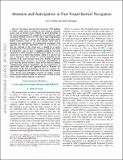| dc.contributor.author | Carlone, Luca | |
| dc.contributor.author | Karaman, Sertac | |
| dc.date.accessioned | 2018-04-13T22:39:06Z | |
| dc.date.available | 2018-04-13T22:39:06Z | |
| dc.date.issued | 2017-07 | |
| dc.date.submitted | 2017-05 | |
| dc.identifier.isbn | 978-1-5090-4633-1 | |
| dc.identifier.isbn | 978-1-5090-4634-8 | |
| dc.identifier.uri | http://hdl.handle.net/1721.1/114740 | |
| dc.description.abstract | Visual attention is the cognitive process that allows humans to parse a large amount of sensory data by selecting relevant information and filtering out irrelevant stimuli. This papers develops a computational approach for visual attention in robots. We consider a Visual-Inertial Navigation (VIN) problem in which a robot needs to estimate its state using an on-board camera and an inertial sensor. The robot can allocate limited resources to VIN, due to time and energy constraints. Therefore, we answer the following question: under limited resources, what are the most relevant visual cues to maximize the performance of visual-inertial navigation? Our approach has four key features. First, it is task-driven, in that the selection of the visual cues is guided by a metric quantifying the task performance. Second, it exploits the notion of anticipation, since it uses a simplified model for forward-simulation of robot dynamics, predicting the utility of a set of visual cues over a time horizon. Third, it is efficient and easy to implement, since it leads to a greedy algorithm for the selection of the most relevant visual cues. Fourth, it provides formal performance guarantees: we leverage submodularity to prove that the greedy selection cannot be far from the optimal (combinatorial) selection. Simulations and real experiments on agile micro aerial vehicles show that our approach leads to dramatic improvements in the VIN performance. In the easy scenarios, our approach outperforms the state of the art in terms of localization errors. In the most challenging scenarios, it enables accurate visual-inertial navigation while the state of the art fails to track robot's motion during aggressive maneuvers. | en_US |
| dc.publisher | Institute of Electrical and Electronics Engineers (IEEE) | en_US |
| dc.relation.isversionof | http://dx.doi.org/10.1109/ICRA.2017.7989448 | en_US |
| dc.rights | Creative Commons Attribution-Noncommercial-Share Alike | en_US |
| dc.rights.uri | http://creativecommons.org/licenses/by-nc-sa/4.0/ | en_US |
| dc.source | arXiv | en_US |
| dc.title | Attention and anticipation in fast visual-inertial navigation | en_US |
| dc.type | Article | en_US |
| dc.identifier.citation | Carlone, Luca, and Sertac Karaman. “Attention and Anticipation in Fast Visual-Inertial Navigation.” 2017 IEEE International Conference on Robotics and Automation (ICRA), May 2017, Singapore, Singapore, 2017. | en_US |
| dc.contributor.department | Massachusetts Institute of Technology. Department of Aeronautics and Astronautics | en_US |
| dc.contributor.department | Massachusetts Institute of Technology. Laboratory for Information and Decision Systems | en_US |
| dc.contributor.mitauthor | Carlone, Luca | |
| dc.contributor.mitauthor | Karaman, Sertac | |
| dc.relation.journal | 2017 IEEE International Conference on Robotics and Automation (ICRA) | en_US |
| dc.eprint.version | Author's final manuscript | en_US |
| dc.type.uri | http://purl.org/eprint/type/ConferencePaper | en_US |
| eprint.status | http://purl.org/eprint/status/NonPeerReviewed | en_US |
| dc.date.updated | 2018-03-22T16:58:27Z | |
| dspace.orderedauthors | Carlone, Luca; Karaman, Sertac | en_US |
| dspace.embargo.terms | N | en_US |
| dc.identifier.orcid | https://orcid.org/0000-0003-1884-5397 | |
| dc.identifier.orcid | https://orcid.org/0000-0002-2225-7275 | |
| mit.license | OPEN_ACCESS_POLICY | en_US |
